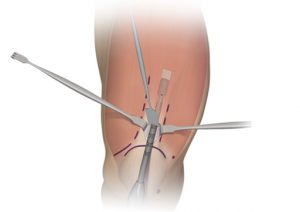Quads tendon grafts for ACL reconstruction: is ‘the new kid on the block’ really all it’s hyped up to be??
Weaker Quadriceps Muscle Strength With a Quadriceps Tendon Graft Compared With a Patellar or Hamstring Tendon Graft at 7 Months After Anterior Cruciate Ligament Reconstruction
Holmgren et al
American Journal of Sports Medicine 2024 Jan; 52(1): 69-76.
doi: 10.1177/03635465231209442
There are a number of different graft types available replacing a torn anterior cruciate with surgical ACL reconstruction. These include:
- taking some of the hamstring tendons from the patient’s own leg (an ipsilateral hamstring tendon autograft)
- taking the central 1/3 of the patellar tendon from the front of the knee, along with a small section of bone at the top, from the patella, and a small section of bone at the bottom, from the tibial tuberosity (an ipsilateral bone-patellar tendon-bone autograft)
- taking tendons from the patient’s other leg (a contralateral autograft) or
- using a donor tendon (an allograft)
Recently, some surgeons have, instead, started taking a section of the tendon from the distal end of the patient’s quadriceps tendon, and using this instead. This allows a nice big chunky graft; however, does this potentially have any negative consequences?…

In this recently published study by Holmgren et al from Stockholm, Sweden, the authors looked at over 100 patients undergoing ACL reconstruction surgery and they tested the patients’ post-op muscle strength at > 6 months post-op, comparing results between the different types of graft that were used.
Their results showed that the patients who had had a distal quads tendon grafts showed significantly greater muscle weakness with a significantly bigger side-to-side difference in strength between their legs (operated side vs non-operated side).
Importantly, impaired quadriceps muscle strength after ACL surgery is known to be associated with poorer clinical outcomes and a bigger risk of reinjury, with graft rupture.
Take home message:
Just cos it’s new or fashionable, doesn’t mean it’s better! … and this very much applies to ACL surgery, like many other things. There are pros and cons with all the different types of tendon that can be used for replacing / reconstructing a torn ACL in a knee, and no type of graft is ‘perfect’. Importantly, however, it is the patient who is having the surgery and who is receiving the graft, and hence the pros and cons of the different graft types really must be discussed with the patient in advance, and ultimately, it is the patient who should be able to pick and choose what specific type of graft they might want to have implanted into their knee. (Informed consent!)
To find out more about ACL graft options, CLICK HERE
